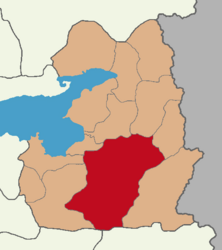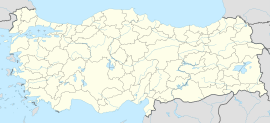Gürpınar (Kurdish: Payizawa/Xawesor,[2] Armenian: Հայոց Ձոր, romanized: Hayots' Dzor) is a municipality and district of Van Province, Turkey.[3] With an area of 4,028 km2 (1,555 sq mi), Gürpınar is the second-largest district of Turkey, after Karaman District.[4] Its population is 31,865 (2022).[1]
Gürpınar
Hayots Dzor / Հայոց Ձոր | |
|---|---|
District and municipality | |
 Map showing Gürpınar District in Van Province | |
| Coordinates: 38°19′37″N 43°24′48″E / 38.32694°N 43.41333°E | |
| Country | Turkey |
| Province | Van |
| Government | |
| • Mayor | Hayrullah Tanış (AKP) |
| Area | 4,028 km2 (1,555 sq mi) |
| Population (2022)[1] | 31,865 |
| • Density | 7.9/km2 (20/sq mi) |
| Time zone | UTC+3 (TRT) |
| Postal code | 65900 |
| Area code | 0432 |
| Website | gurpinar |
The town Gürpınar is located 20 km (12 mi) south of the provincial capital Van. The district has several places of historical interest. The current mayor is Hayrullah Tanış from the Justice and Development Party (AKP).[5] The current kaymakam Fatih Sayar was appointed in August 2019.[6]
Name
editThe area's old Armenian name is Hayots Dzor (Armenian: Հայոց Ձոր, meaning "Valley of the Armenians"). Its Kurdish name is Payizava; however, the Armenian-derived Xawesor is also used. The titular village of Gürpınar itself was also known to Armenians as Kghzi (Armenian: Կղզի, meaning "island", due to it being surrounded by the Shamiram Canal).[7]
History
editIn Armenian mythology, Hayots Dzor is the valley where the Armenian progenitor Hayk defeated the army of the invading Babylonian king Bel and constructed a fortress (Haykaberd) nearby.
In the Middle Ages, the area was a part of the Armenian kingdom of Vaspurakan, ruled by the Artsruni dynasty of Armenian kings.
The village of Kghzi had 241 Armenian and 11 Kurdish inhabitants in 1909 (the wider region of Hayots Dzor was home to about 10,000 Armenians before the Armenian genocide).[7] The Armenian population was massacred or displaced during the Armenian genocide; some of the inhabitants managed to flee and settle in Eastern Armenia.[7]
Historical places
edit- Hoşap Castle
- Çavuştepe, Urartian castle
- Surp Marinos Monastery
- Menua Canal
Composition
editThere are 79 neighbourhoods in Gürpınar District:[8]
- Akbulut
- Akdoğu
- Akpınar
- Alnıak
- Arındı
- Aşağı Kaymaz
- Bağrıyanık
- Beşbudak
- Bölmeçalı
- Bozyiğit
- Bükeç
- Çakınlı
- Çatakdibi
- Çavuştepe
- Çepkenli
- Cevizalan
- Çörekli
- Cumhuriyet
- Dağseven
- Değirmendüzü
- Dikbıyık
- Dolaylı
- Doluçıkın
- Elaçmaz
- Erkaldı
- Geçerli
- Geziyurt
- Giyimli
- Gölardı
- Güleçler
- Günbaşı
- Hacıköy
- Hoşab
- Işıkpınar
- Kalkanlı
- Kapçık
- Karakoç
- Kılıçtutan
- Kırkgeçit
- Koçgüden
- Koyunyatağı
- Kuşdağı
- Mollahüseyin
- Murataldı
- Oğuldamı
- Ongun
- Örmeli
- Ortaköy
- Otbiçer
- Öveçli
- Özlüce
- Parmakkapı
- Sakalar
- Sapakonak
- Savacık
- Sevindik
- Sıcaksu
- Sütlüce
- Taşdöndüren
- Taşlıyazı
- Tepegören
- Topçudeğirmeni
- Topsakal
- Topyıldız
- Tutak
- Tutmaç
- Üçdoğan
- Üçgen
- Umut
- Uzungedik
- Yalınca
- Yaramış
- Yatağan
- Yedisalkım
- Yolaşan
- Yoldüştü
- Yukarı Kaymaz
- Yurtbaşı
- Zernek
References
edit- ^ a b "Address-based population registration system (ADNKS) results dated 31 December 2022, Favorite Reports" (XLS). TÜİK. Retrieved 19 September 2023.
- ^ Adem, Avcıkıran (2009). Kürtçe Anamnez Anamneza bi Kurmancî (in Turkish and Kurdish). p. 57.
- ^ Büyükşehir İlçe Belediyesi, Turkey Civil Administration Departments Inventory. Retrieved 19 September 2023.
- ^ "İl ve İlçe Yüz ölçümleri". General Directorate of Mapping. Retrieved 19 September 2023.
- ^ "Van Gürpınar Seçim Sonuçları - 31 Mart Van Gürpınar Yerel Seçim Sonuçları". secim.haberler.com (in Turkish). Retrieved 2020-05-19.
- ^ "Gürpınar Kaymakamı Fatih Sayar". www.gurpinar.gov.tr. Retrieved 2020-05-19.
- ^ a b c Hakobyan, Tadevos Kh.; Melik-Bakhshyan, Stepan T.; Barseghyan, Hovhannes Kh. (1991). Հայաստանի և հարակից շրջանների տեղանունների բառարան [Dictionary of toponymy of Armenia and adjacent territories] (in Armenian). Vol. 3. Yerevan: Yerevan State University Publishing House. p. 158.
- ^ Mahalle, Turkey Civil Administration Departments Inventory. Retrieved 19 September 2023.
External links
edit
